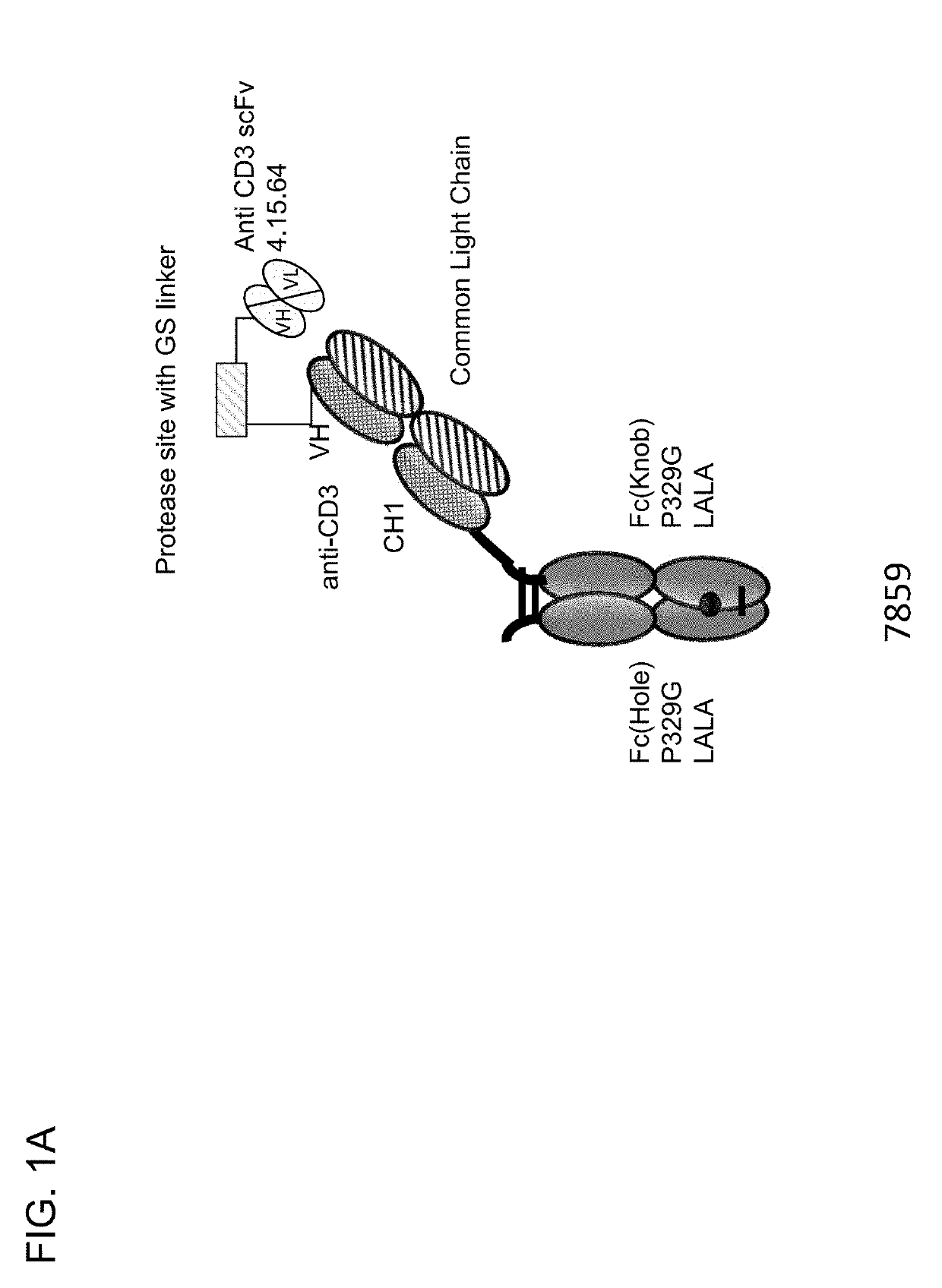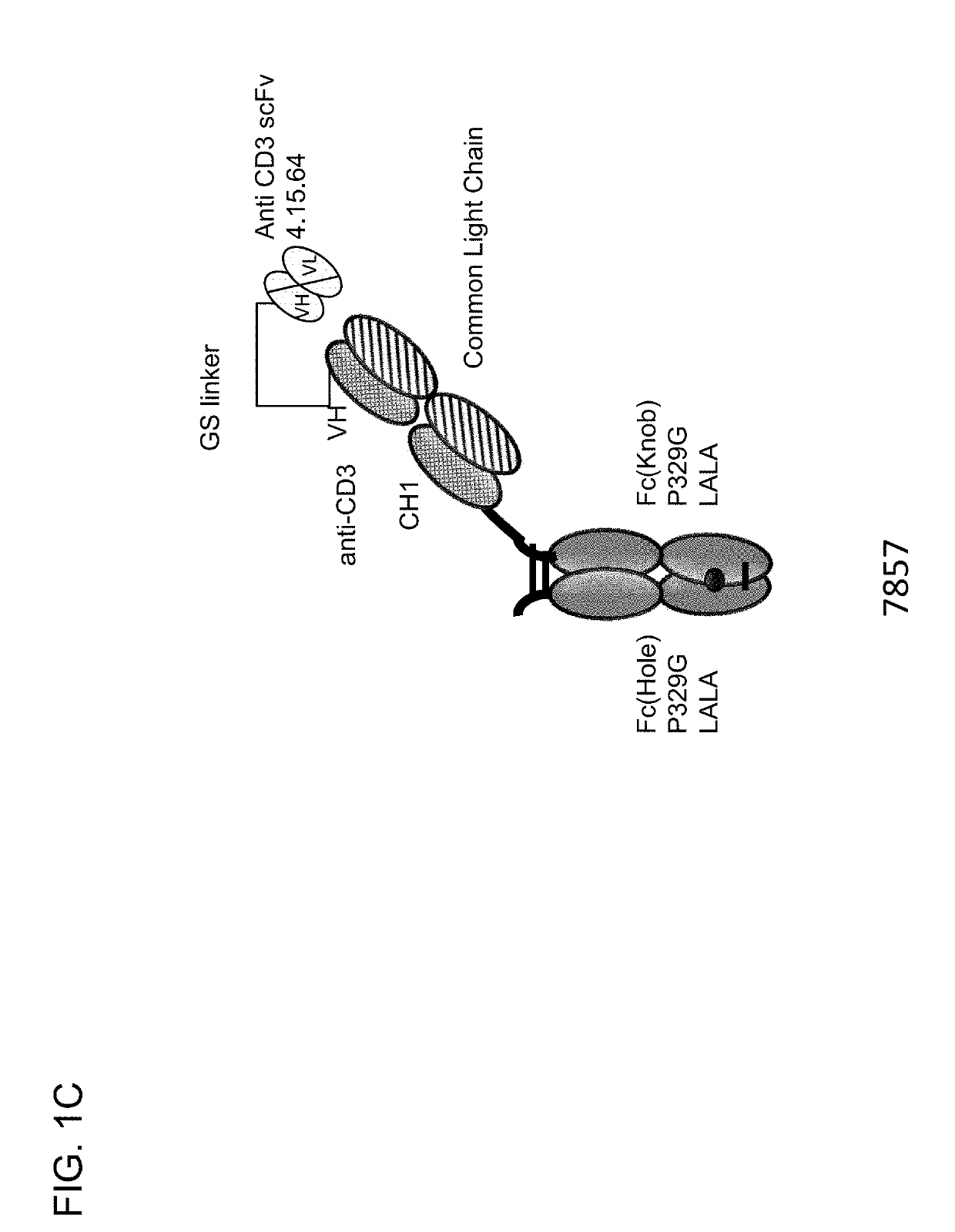Protease-activated t cell bispecific molecules
a t cell activation and protease technology, applied in the field of protease activation-activated antigen-binding molecules, can solve problems such as toxicity, and achieve the effect of reducing in vivo toxicity of t cell activation
- Summary
- Abstract
- Description
- Claims
- Application Information
AI Technical Summary
Benefits of technology
Problems solved by technology
Method used
Image
Examples
example 1
Synthesis of Monovalent Anti-CD3 IgG Molecules with Anti-Idiotypic scFv
[0733]Described herein are CD3 binders that are masked with an N-terminally linked anti-idiotypic CD3 scFv. These constructs include a protease recognition site which is recognized by a tumor specific protease. In the presence of protease-expressing tumor cells, the linker connecting the masking moiety will be cleaved and, thereby, CD3 binding by the CD3 binder is recovered. Several monovalent anti-CD3 IgG molecules with various anti-idiotypic scFv were produced and are schematically depicted in FIGS. 1A-1E with their respective ID number. The following molecules were prepared:[0734]Identification No. 7859: monovalent CD3 IgG, (anti-idiotypic scFv 4.15.64-MK062 Matriptase site-CD3-N-terminal fused to CD3 Fab-inert Fc) with N-terminal fused anti CD3 scFv 4.15.64 and protease-cleavable linker.[0735]Identification No. 7860: monovalent CD3 IgG, (anti-idiotypic scFv 4.32.63-MK062 Matriptase site-CD3-N-terminal fused t...
example 2
Cleavage and Stability of Protease Activated IgGs
[0747]Capillary Electrophoresis of protease activated IgG molecules. Comparison of untreated sample and treated sample showed that the anti-ID scFv was completely cleaved off after treatment with rhMatriptase / ST14 (R&D Systems) indicated by the size shift in the SDS page analysis (FIG. 3). Analysis of samples incubated for 48 h at 37° C. confirmed stability of the molecules in formulation buffer (FIG. 3A-D).
example 3
Masking Effect of Anti-Idiotypic scFv for CD3 IgG
[0748]The efficiency of masking the CD3 binder by N-terminal fusion of an anti-idiotypic CD3 scFv was shown by a Jurkat-NFAT reporter assay. Jurkat-NFAT reporter cells (a human acute lymphatic leukemia reporter cell line with a NFAT promoter-regulated luciferase expression, GloResponse Jurkat NFAT-RE-luc2P, Promega #CS176501) express active firefly luciferase if the NFAT promoter is activated by binding of CD3ε. The intensity of the luminescence signal upon addition of luciferase substrate is proportional to the intensity of CD3 activation and signaling. Completely unmasked monovalent CD3 molecules served as a positive control. The treatment was done with rhMatriptase / ST14 (R&D Systems) for 48 h at 37° C. In parallel Bug / ml Anti human Fc Antibody (BioLegends) were coated in 0.025 ul / well PBS for 48 h at 4° C. in white-walled, clear bottom 96-well (flat)-plate (Greiner Bio-One). PBS was removed by pipetting before monovalent IgGs were ...
PUM
| Property | Measurement | Unit |
|---|---|---|
| dissociation constant | aaaaa | aaaaa |
| dissociation constant | aaaaa | aaaaa |
| dissociation constant | aaaaa | aaaaa |
Abstract
Description
Claims
Application Information
 Login to View More
Login to View More - R&D
- Intellectual Property
- Life Sciences
- Materials
- Tech Scout
- Unparalleled Data Quality
- Higher Quality Content
- 60% Fewer Hallucinations
Browse by: Latest US Patents, China's latest patents, Technical Efficacy Thesaurus, Application Domain, Technology Topic, Popular Technical Reports.
© 2025 PatSnap. All rights reserved.Legal|Privacy policy|Modern Slavery Act Transparency Statement|Sitemap|About US| Contact US: help@patsnap.com



